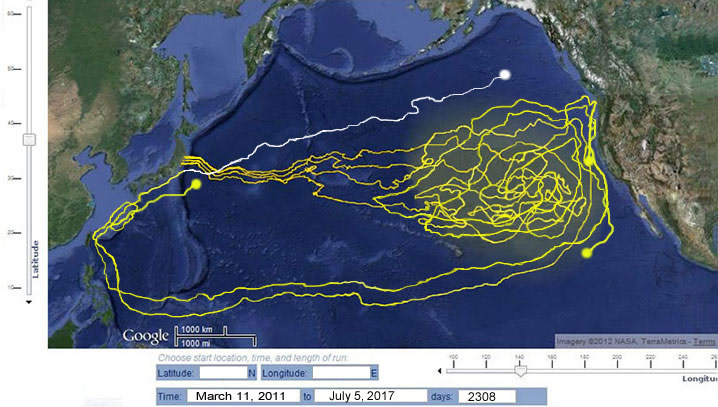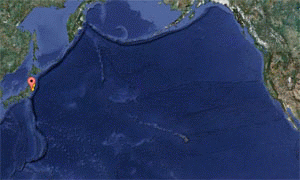 |
 |
Japan Tsunami Debris |
|
March 11, 2011: A magnitude 9.0 earthquake struck Japan, triggering a massive tsunami. The Government of Japan estimated in March 2012 that the tsunami swept about 5 million tons of debris into the ocean and that about 70% sank quickly. The remaining debris was dispersed far across the North Pacific, an area of ocean roughly three times the size of the lower 48 states. Some debris have already reached US and Canadian shores, and is expected to continue over the next several years. At this time, there is no way to accurately estimate how much debris is still floating - some likely sank or deteriorated.
|
| |
The highlighted area shows the highest density of Japan tsunami debris as of
July 5, 2017, 2308 days after the tsunami occurred.  |
| |
| Simulation and animation were generated by Islands4Kids |
Simulation Data: Courtisy of NOAA |
| |
|
| |
This animation was created by ISLANDS4KIDS to keep track of projected tsunami-related debris drifting for the past 6 years and 4 months.
There are four different courses. Three beginning at major prefectures (Iwate, Miyagi, Fukushima) and one from the Fukushima nuclear power plant hit by the tsunami.
(To identify ocean currents were referred to NOAA’s OSCURS database.) |
 |
|
| |
|
 |
General Overview of Japan Tsunami Debris |
| |
Islands4Kids concluded the Japan Tsunami related marine debris simulation in July 2017, after 6 years and 4 months of research. All of the information utilized for the month by month course simulation was referenced from NOAA’s Ocean Surface Current Simulator (OSCURS).
Through our monthly marine debris trajectory predictions, we can revalidate the general gyre course of the Kuroshio (Black Current) at the Northern Pacific Ocean. We can also visualize the physical mechanism of how marine debris accumulates as what is known as the “Garbage Patch” in the middle of the Northeastern Pacific Ocean. It is created by the vortex activities of many branched off currents.
Although the total quantity of debris is small, we found twelve debris that are presumably linked to the Japan tsunami of March 11, 2011. Due to the impact of the Fukushima Daiichi nuclear power plant accident, we also measured the radiation dose of the air, beach sand, ocean water, and seaweeds washed ashore at Ocean Shores. During our research, we did not identify any unusual or higher dose of radiation. |
| |
| |
|
| |
|
 |
Tsunami Debris at Ocean Shores |
| |
Here are the marine debris that we collected that are presumably linked to the Japan tsunami of March 11, 2011. |
| |
|
| |
|
| |
|